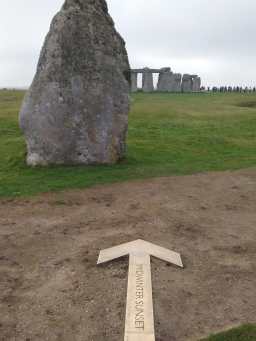A day out at Stonehenge: they say back in the day, you could park next to the pitted, sacred stones and sit on them while eating crisps and a Jacob’s Orange Club biscuit. Then you and your family of five would climb back into your Austin Allegro, which was only slightly larger than one of those crates dogs go in, and off you would go. People I have met who did this said it was “alright,” and “a nice enough place to stop, but not as big as you think it will be.”
But the 70s were a different time.
Nowadays, an attraction that has been free for most of human recorded history requires a hefty entrance fee. Which is why I didn’t go until I was training to be a teacher of primary-aged children. Knowing about Stonehenge seemed like the kind of thing a primary teacher should be.
We also realised that the entrance fee isn’t that bad if you buy a membership to English Heritage. This gets you into lots of places around England and works out as pretty good value even if you only use it a couple of times.
You could of course slow down a bit on the A303, and contribute to the endless traffic jam of people doing the same. You can see the stones surprisingly well from a car window. But then you would end up with a picture that looks like this and everyone behind will be beeping you.

The Stonehenge site
I am going to be honest that I had low expectations for visiting Stonehenge. I have seen some amazing temple sites in the world–like Angkor Wat– let alone all the amazing things to see in Britain, and I really wasn’t sure how a collection of roughly-hewn standing stones you need a ticket to even get near was going to cut it.
There was a lot of negative press about the introduction of the fee, and the costly visitor centre, which then requires a little land train to get to the roped-off enclosure. Which is part of the reason we didn’t go before.
We parked our car in the large car park, and I am not totally sure why, but it did already feel a bit special. There is a lot of tourist infrastructure pointing you to the stones. Road signs begin announcing them well before your arrival, and there are coach parks before you get to the parking area for cars. So you get a sense that you are going somewhere. Furthermore, the countryside is stunning. The rolling fields of Salisbury plain are filled with a quiet and desolate beauty, and the clever positioning of the visitor’s centre does a good job of exposing that. You can see a lot of sweeping countryside from the centre, but not the stones themselves.
The visitor’s centre itself is great. There is an interesting museum which provides a fascinating back story to the stones, druids and the culture of the ancient Britons who worshipped them. It would be a shame to miss out on this as it builds your understanding of the significance of the site quite a bit. We realised that we were part of a very long line of people journeying to pay respect to the site.
You can either get the land train straight to the stones or get off a bit before and walk. We got the train, which was fun, and then walked. You pass burial mounds on the way which themselves feel imbued with an eery place in history.

As we finally approached the stones, our voices naturally hushed. We could see that there were many people already there, standing around the perimeter of the monolith. As we got close, we found they too were quiet.

The stones themselves are majestic. Tall slabs of grey rock sit immovably, planted in the earth. You can almost feel their long history as the days and nights fly by around them – totalling millennia. Perhaps it was the fact that so many people were there, all so silent like worshippers in a disjointed cathedral, but they seemed to emanate a weird aura of silence and peace.

The grisly history of Stonehenge
Yet something is unsettling about the stones. Where did they come from? Why are they there? We may never know for sure, and druidism is lost forever. The Romans feared and disliked the druids so much they erased them from Britannia. This is odd in itself because the Romans generally didn’t care much what religions their conquered citizens followed–as long as they paid their taxes.
So what was the Roman’s problem? They thought that the druids were cannibals. Skeletons buried around stone-circle sites may even support this. Bones are nicked and chopped, which is consistent with the body being hacked up. Perhaps the druids enjoyed the most grisly of all meals after a ritual sacrifice. With rosemary. And thyme.
In any case, it really wouldn’t have been the same if you could sit on them eating your lunch.
Getting to Stonehenge for your day out
Salisbury is about 9 miles away. From there, you can get a bus. There are many companies offering coach tours from London and other places. Easiest is to drive.
When we went, we needed to pre-book the time we were going for the parking, so be mindful of that.

